Multiple
Choice
Identify the choice that best completes the statement or answers the
question.
|
|
|
Technology and City
Life
Many people crossed the Brooklyn Bridge each day on their way to and from work. After
all, it was the increasing number of industrial jobs more than any other factor that drew people to
America's cities. By 1890, Chicago and Philadelphia claimed more than a million residents. By
1900, New York boasted a population of 3.5 million people.
In 1870, only 25 American cities
had populations of 50,000; by 1890, 58 cities could make that claim. Four out of ten Americans made
their homes in cities by the turn of the century. As rural and immigrant people entered the cities,
one enthusiastic city dweller hailed the "mighty streams of human beings that forever flow up
and down the thoroughfares."
To accommodate these streams of people, cities needed to
expand upward as well as outward. Technological advances, like the ones that contributed to the
construction of the Brooklyn Bridge, soon began to meet the urbanizing nation's needs for space,
transportation, and communication. One remedy for the evershrinking space for new residents was to
build upward.
| |
|
|
|
1.
|
From the reading we can tell that the late 1800’s saw
a. | a population shift from the rural areas to the cities | c. | a population that did not move but
remained in their traditional areas | b. | a population shift from the cities to the rural
areas of the country | d. | the
growth of America’s recovery from the Civil War and the rebirth of the
South |
|
|
|
2.
|
What was the main reason Americans moved into the cities in the Gilded
Age?
a. | an increase in farm jobs | c. | it was easier to get social
services, such as welfare, in the cities | b. | a need for workers in the industrial
cities | d. | city life was
boring |
|
|
|
3.
|
Which people account for the dramatic growth in population in the major American
Cities?
a. | rural people | c. | rural people and immigrants | b. | immigrants | d. | neither rural people nor immigrants |
|
|
|
4.
|
Which urban needs were met with the advances in new technology?
a. | communications | c. | transportation | b. | space | d. | all of these |
|
|
|
5.
|
Technology helped the cities to overcome the shortage of space by
a. | building in the rural areas | c. | building taller
buildings | b. | building new roads to the suburbs | d. | building more
bridges |
|
|
|
SKYSCRAPERS
Architects were able to design taller buildings than ever
before because of two factors: the invention of elevators and the development of internal steel
skeletons to bear the weight of buildings. In 1890, the architectural pioneer Louis Sullivan designed
the ten-story Wainwright Building in St. Louis, which he called a "proud and soaring
thing." The tall building's appearance was graceful because its steel framework supported
both floors and walls. The unusual form of another skyscraper, the Flatiron Building, seemed perfect
for its location at one of New York's busiest intersections. Daniel Burnham designed this
slender 285-foot tower in 1902.
The skyscraper soon became America's greatest
contribution to architecture, "a new thing under the sun" according to the architect Frank
Lloyd Wright, who studied under Sullivan. Skyscrapers solved the practical problem of how to make the
best use of limited and expensive space. The buildings also served as towering symbols of a rich and
optimistic society.
| 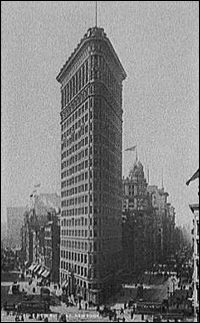 New York Flatiron
Building New York Flatiron
Building | | |
|
|
|
6.
|
What factors allowed architecs to build building taller?
a. | use of steel frames | d. | invention of glass | b. | c and d | e. | a and d | c. | invention of
elevators | f. | none of
these |
|
|
|
7.
|
In what year was the Flatiron Building built?
|
|
|
8.
|
The skyscraper became a symbol for America’s
a. | economic power and positive attitude | c. | desire for stability and slow
growth | b. | economic corruption | d. | military power |
|
|
|
ELECTRIC TRANSIT
As skyscrapers expanded upward, changes in transportation allowed
cities to spread outward. Before the Civil War, horses had drawn the earliest streetcars over iron
rails embedded in city streets. In some cities during the 1870s and 1880s, underground moving cables
powered streetcar lines. Electricity, however, transformed urban transportation.
In 1888,
Richmond, Virginia, became the first American city to electrify its urban transit. After Richmond
installed streetcars driven by electric motors powered by an overhead wire, other cities installed
electric streetcars. By the turn of the century, intricate networks of electric streetcar lines
carried the residents of outlying neighborhoods to downtown department stores, offices, banks, and
factories. In Kansas City in 1891, a journalist named William Allen White exclaimed that the
city's streetcars were "marvels." The small "walking city," whose limits
depended on how far people's legs could carry them, soon gave way to a sprawling metropolis
crisscrossed with mass transit lines.
New railroad lines also fed the growth of suburbs, whose
residents could now commute to downtown jobs. By 1890,
|
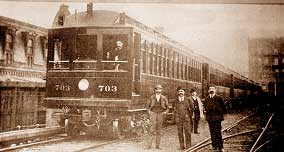
70,000 suburban commuters made the daily trip to
Chicago. New York's northern sub urbs alone supplied 100,000 commuters each day to the central
business district.
Faced with congestion on their streets, a few large cities moved their
streetcars above street level, creating elevated or "el" trains. Other cities. like New
York, built subways by moving their rail lines underground. These streetcars, elevated trains, and
subways enabled cities to annex suburban developments that mushroomed along the advancing
transportation routes. Indeed, many suburbs wanted to be annexed by the larger cities so that the
train lines would reach them. Between 1860 and 1890, Boston grew from 5 square miles to 39 square
miles. At the same time, Chicago expanded from 17 square miles to 178 square miles.
| | |
|
|
|
9.
|
The earliest streetcars were powered by
a. | electricity | c. | horses | b. | the gasoline engine | d. | diesel engines |
|
|
|
10.
|
By the late 1800’s streetcars were being powered by
a. | the internal combustion engine | c. | teams of horses | b. | electricity | d. | the new diesel engines |
|
|
|
11.
|
The surrounding suburbs also began to grow as the cities grew. What major factor
contributed to the growth of the suburbs?
a. | the skyscraper | c. | the invention of the airoplane | b. | new suburbian
farming methods | d. | new
railroad lines |
|
|
|
12.
|
Which graphic below illustrates an el?
|
|
|
13.
|
How did the cities react to the growth of the suburbs?
a. | the cities began to break-up into smaller metropolitan units | c. | incorporated the
suburbs making the cities grow even bigger. | b. | the cities diminished in
importance. | d. | fought the
development of outlying suburbs |
|
|
|
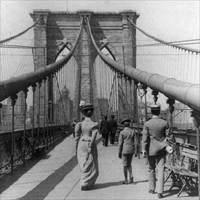
Brooklyn Bridge
Promenade |
Steel-cable suspension bridges, of which the
Brooklyn Bridge proved the most spectacular example, also brought cities' sections closer
together. Sometimes these bridges even provided recreational opportunities. In his design for the
Brooklyn Bridge, for example, John Augustus Roebling provided an elevated promenade whose
"principal use will be to allow people of leisure, and old and young invalids, to promenade over
the bridge on fine days, in order to enjoy the beautiful views and the pure air." This need for
open spaces in the midst of crowded commercial cities inspired the emerging science of urban
planning.
| | |
|
|
|
14.
|
Bridges like the Brooklyn Bridge helped to
a. | divided the city into ethnic neighborhoods | c. | keep the citizens in the
cities | b. | connect different parts of the city together | d. | isolate the people in the
cities |
|
|
|
15.
|
The graphic and text shows that city people had a desire
a. | to avoid open spaces | c. | to walk to work | b. | find relief from city congestion in open
spaces | d. | avoid
bridges |
|
|
|
THE SCIENCE OF URBAN PLANNING
Even before skyscrapers and advances in
transportation began to make life in the cities more comfortable, city planners in several cities
sought to restore a measure of serenity to the urban environment by designing parks and recreational
areas. Frederick Law Olmsted-farmer, surveyor, and journalist -spearheaded the movement for planned
urban parks. In 1858, Olmsted teamed with the English architect Calvert Vaux to draw up a plan for
"Greensward," which became Central Park, in New York. Olmsted envisioned the park as a
rustic haven in the cen ter of the busy city. The finished park featured boating and tennis
facilities, a zoo, and bicycle paths, with curved roadways that provided a pleasing contrast to the
straight-line grid of New York's streets. Olmsted hoped that the park's beauty would soothe
the city's inhabitants and let them enjoy a "natural" setting.
In the 1870s,
Olmsted planned landscaping for Washington, D.C., and St. Louis. He also drew the initial designs for
the Fenway Boston's park system. Boston's Back Bay area, originally a 450-acre swamp, was
drained and developed into an area of elegant streets and cultural attractions.
By contrast,
Chicago, with its explosive growth from 30,000 people in 1850 to 300,000 in 1870, represented a
nightmare of unregulated expansion. As Rudyard Kipling complained of the city, "Having seen it,
I urgently desire never to see it again." Fortunately for the growing city, the Chicago
architect Daniel Burnham was intrigued by the prospect of remaking the city. Burnham's motto was
"Make no little plans. They have no magic to stir men's blood." He oversaw the
transformation of a swampy area near Lake Michigan into a glistening White City for Chicago's
1893 Columbian Exposition. Majestic exhibition halls, statues, and a lagoon greeted 27 million
visitors who came to the city.
Many urban planners saw in Burnham's White City glorious
visions of future cities. Burnham, however, left Chicago an even more important legacy: an overall
plan for the city, crowned by elegant parks strung along Lake Michigan. As a result, Chicago's
lakefront today features curving banks of grass and sandy beaches instead of a jumbled mass of piers
and warehouses.
| |
|
|
|
16.
|
How did city planners in seek to restore a measure of serenity to the urban
environment?
a. | By making it easier for city people to get out of the cities | c. | by building city
parks | b. | by restricting the growth of sky scrappers | d. | by limiting
immigration |
|
|
|
17.
|
From the passage above we can infer that the author
a. | is in favor of urban planning | c. | has no opinion on urban
planning | b. | is opposed to urban planning | d. | is a Republican |
|
|
|
New Technologies Transform Communications
While science and technology pushed
American cities upward and outward, new developments in communications brought people closer together
in time. In addition to a railroad network that now spanned the nation, advances in aviation,
printing, and photography helped to speed the transmission of information.
AIRPLANES AND
MAIL DELIVERY
During the early 20th century, Orville and Wilbur Wright, two brothers who
manufactured bicycles in Dayton, Ohio, experimented with new engines powerful enough to keep
"heavier-than-air" craft aloft. The Wright brothers began by building a glider. Eventually
they built their own four-cylinder internal combustion engine, chose a propeller, and designed a
biplane with a 40-foot wingspan. Their first successful flight-on December 17, 1903, at Kitty Hawk,
North Carolina-covered 120 feet and lasted 12 seconds.
The public paid little attention to the
Wright brothers' achievement. Only a few newspapers in the country even bothered to print the
story. The rest probably shared the "national suspicion that the sky was a place only for birds,
angels, and fools." Within two years, however, the Wright brothers were making flights of 24
miles. By 1908, the pioneer aviators had attracted the interest of the U.S.
government.
|
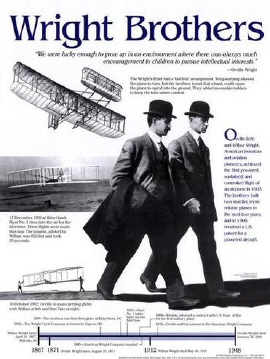
Convinced of the great
potential of flight, the government established the first transcontinental airmail service in 1920.
At first, it took a day and a half for mail to travel between New York and San Francisco. The mail
planes flew only in the daytime; at night the mail continued by train. By 1925, however, 61 of the 96
planes flying the mail could fly at night.
| | |
|
|
|
18.
|
What was the effect of imporved communications at the start of the
1900’s?
a. | it drove people apart | c. | it brought people closer together | b. | it made people
afraid of outsiders | d. | it made
people feel more isolated |
|
|
|
19.
|
Who were the first Americans to fly an airplane
a. | the Wright Brothers | c. | Charles Lindburgh and his father | b. | the Kitty Hawk towns
people | d. | none of these were
the first Americans to fly an airplane |
|
|
|
20.
|
The first airplane flight took place in ____ ; the first transcontinental
airmail service took place in _____ and by _____ most of the planes were flying at night.
a. | 1903 - 1925 - 1920 | c. | 1903 - 1920 - 1925 | b. | 1920 - 1925 - 1935 | d. | 1925 - 1920 -
1935 |
|
|
|
21.
|
Which statement is true.
a. | The plublic saw the importance of flight right away but the government was slow to
react | c. | The government and the general public ignored manned flight. | b. | The government was
quick to see the importance of flight and invested in the new technology | d. | Manned flight did not come into use until
1935 |
|
|
|
A REVOLUTION IN PRINTING
Thanks to better public education, the literacy
rate in the United States had risen to nearly 90 percent by 1890. As Americans demonstrated an
increased interest in reading, publishers turned out ever increasing numbers of books, magazines, and
newspapers to meet the demand.
A series of technological advances in printing aided their
efforts. Less expensive paper and better printing presses helped lower the cost of printing. After
chemists discovered that wood pulp could be used to make paper, American mills began to produce huge
quantities of cheap paper. The new paper proved durable enough to withstand high-speed presses like
the one invented by William Bullock. His electrically powered web-perfecting press printed on both
sides of a continuous paper roll, rather than on just one side, then cut, folded, and counted the
pages as they came down the line. Faster production and lower costs made newspapers and magazines
more affordable.
People could now buy newspapers for a penny a copy, and the price of most
magazines plunged from about 25 cents to a nickel. New inventions also sped the tedious process of
typesetting. The Linotype machine, which was invented by Ottmar Mergenthaler and first used by a
newspaper in 1886, streamlined the process of setting type. Illustration also became easier in the
1880s, when the process of chemical engraving enabled printers to reproduce paintings and photographs
cheaply and accurately. As a result, illustrations filled newspapers, magazines, and books and became
even more commonplace as photography improved.
| | | |
|
|
|
22.
|
The literacy rate in the U.S. today is about 80%, In 1890 the U.S, literacy rate
was
|
|
|
23.
|
How did printing technology help to improve the literacy rate?
a. | the publishers were able to put more pictures in the things they
published | c. | it financed the education system which taught more people to read | b. | it created more rich
people who are naturally better readers | d. | it made books and newspapers cheap enough for common people to
afford |
|
|
|
24.
|
The passage above shows how technology
a. | can improve peoples lives | c. | serves only the
rich | b. | can destroy peoples lives | d. | makes slaves out of common people |
|
|
|
25.
|
The linotype machine is used to set letters in a press for printing. It imporved
the old process of setting the letters by hand. Who invented the linotype machine?
a. | John Willey and Sons | c. | Thomas Edison | b. | William Bulloch | d. | Ottmar
Mergenthaler |
|
|
|
26.
|
American chemists discovered that cheap paper could be made from
a. | wood pulp | c. | a mixture of oil and tree bark | b. | sand | d. | cotton
|
|
|
|
PHOTOGRAPHY FOR EVERYONE
Before the 1880s, photography was a
professional activity, difficult for the casual hobbyist. Because of the time required to take a
picture and the weight of the equipment, a photographer could not shoot a moving object. In addition,
photographers had to develop their shots immediately. New techniques eliminated the need to develop
pictures right away. George Eastman developed a paper-based film as an alternative to the
heavy glass plates previously used. Now, instead of carrying their darkrooms around with them,
photographers could send their film to a studio for processing. When professional photographers were
slow to begin using the new film, Eastman decided to aim his product at the masses
In 1888,
Eastman introduced his Kodak camera. Easily held and operated, the Kodak prompted millions of
Americans to become amateur photographers. The camera also helped to create the field of
photojournalism. Reporters could now photograph events as they occurred. When the Wright brothers
first flew their simple airplane at Kitty Hawk, an amateur photographer captured the first successful
flight oil film. Transformations in communication, transportation, and the use of space reshaped the
American landscape toward the end of the 19th century. At the same time, developments in education
changed the American lifestyle.
|
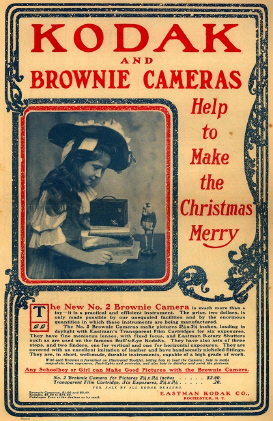 | | |
|
|
|
27.
|
George Eastman made photography available to
a. | the common people | c. | professional photographers only | b. | rich people who
could afford it | d. | the Wright
Brothers |
|
|
|
28.
|
George Eastman was a
a. | greedy businessman | c. | creative inventor | b. | greedy politician | d. | Senator from New
York |
|
|
|
29.
|
Advances in photography were part of the revolution in
a. | transportation | c. | communications | b. | physics and astronomy | d. | economics |
|